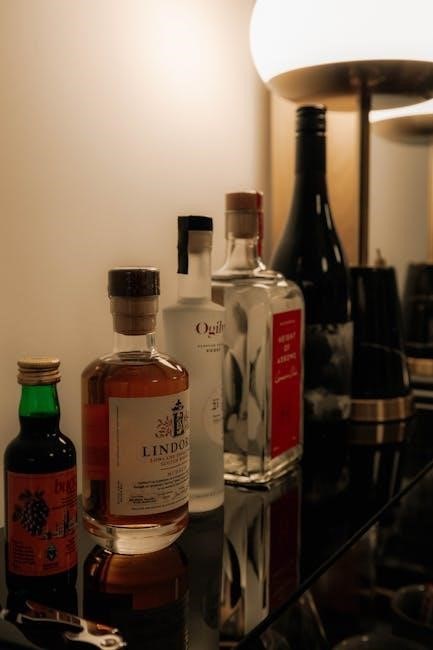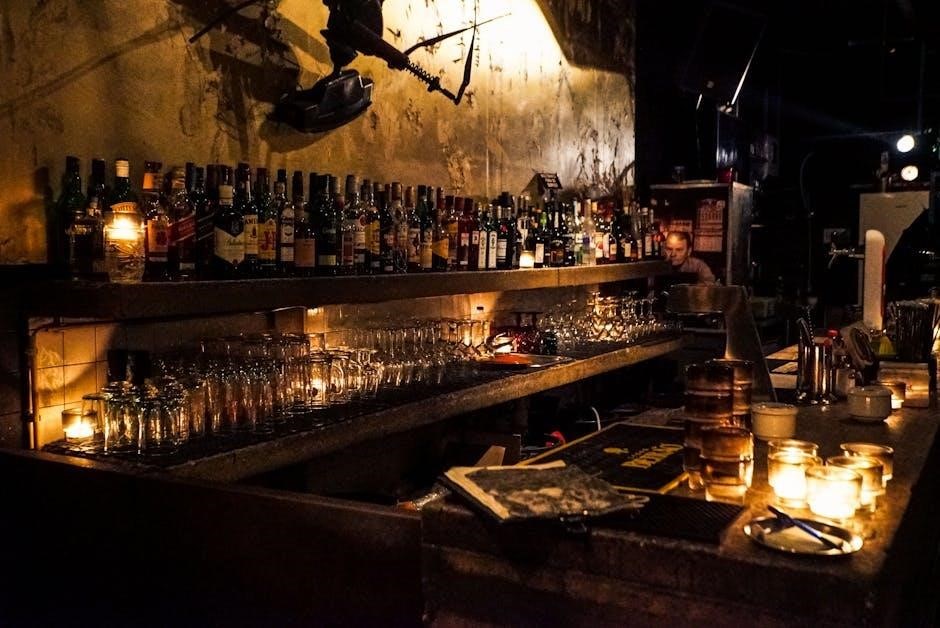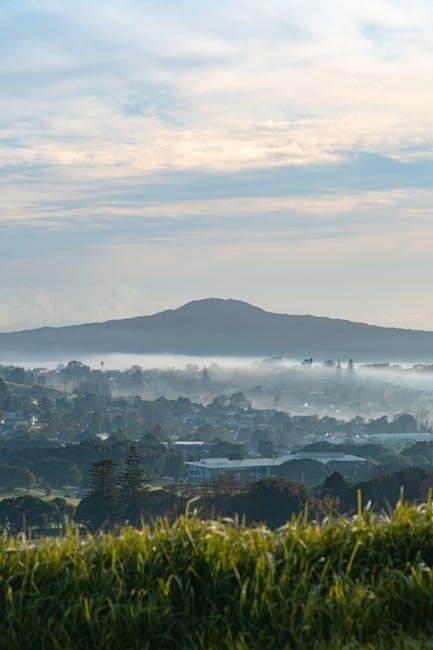Bourbon whiskey, America’s native spirit, is cherished for its rich history, distinct flavor, and craftsmanship. Its value is shaped by aging, ingredients, and distillery reputation.
1.1 What is Bourbon Whiskey?
Bourbon whiskey is a distinctive type of whiskey primarily produced in the United States, with its roots deeply embedded in American history and culture. To be classified as bourbon, the spirit must meet specific criteria: it must be made from at least 51% corn mash, aged in new, charred oak barrels, and distilled to no more than 160 proof. Additionally, it cannot contain any added flavorings or colorings. Bourbon is known for its rich, full-bodied flavor profile, which ranges from sweet caramel and vanilla notes to spicy and smoky undertones, depending on the aging process and mash bill. Its unique characteristics and legal standards make it a cornerstone of American whiskey production.
1.2 Factors Affecting Bourbon Value
The value of bourbon whiskey is influenced by several key factors, including age, mash bill, distillery reputation, and rarity. Older bourbons typically command higher prices due to the complexity developed during extended aging. The proportion of corn, rye, and other grains in the mash bill can also impact flavor and desirability. Distilleries with a strong legacy, such as Buffalo Trace or Blanton’s, often see higher valuations due to their historical significance. Additionally, limited production runs and special editions create scarcity, driving up demand and prices. Market trends and secondary market dynamics further amplify these factors, making bourbon value a dynamic and multifaceted aspect of whiskey enthusiasts’ interests.

Bourbon Price Ranges and Tiers
Bourbon whiskey is categorized into distinct price tiers, ranging from budget-friendly options under $50 to luxury bottles exceeding $250, offering choices for every enthusiast and budget.
2.1 Budget-Friendly Bourbons (Under $50)
Budget-friendly bourbons offer exceptional value without compromising on quality. Bottles like Allegiant 4 Year Kentucky Straight Bourbon, priced at $29.99, provide smooth, approachable flavors. American Highway Reserve Bourbon is another affordable option, offering rich, balanced notes. These bourbons are ideal for newcomers and casual drinkers, delivering satisfying taste profiles at accessible prices. They often feature classic bourbon characteristics, such as vanilla, oak, and caramel, making them great for sipping or mixing. While they may not have the complexity of premium bourbons, their affordability and consistency make them standout choices. Perfect for everyday enjoyment, these bourbons prove that quality doesn’t always come with a high price tag.
2.2 Mid-Range Bourbons ($50-$100)
Mid-range bourbons offer a balance of quality and affordability, catering to both enthusiasts and casual drinkers. Bottles like Blantons, priced between $60-$160, fall into this category, offering rich, complex flavors. These bourbons often feature extended aging processes, resulting in deeper notes of oak, vanilla, and spice. They are ideal for those seeking a step-up from budget options without reaching premium prices. Mid-range bourbons are versatile, suitable for sipping or crafting cocktails. Their appeal lies in their consistency and flavor profiles, making them a favorite among collectors and everyday drinkers alike. This tier provides excellent value for those looking to explore higher-quality bourbons.
2.3 Premium Bourbons ($100-$250)
Premium bourbons in the $100-$250 range represent exceptional craftsmanship and limited production. Bottles like Russell’s Reserve Single Barrel Bourbon, priced at $70, offer complex flavors with notes of oak, vanilla, and caramel. These bourbons are aged for extended periods, enhancing their depth and character. They often come from renowned distilleries, ensuring high quality and consistency. Premium bourbons are sought after by serious collectors and connoisseurs, offering a luxurious drinking experience. Their higher price reflects the meticulous distillation process, rare ingredients, and exclusive releases. This tier is ideal for special occasions or as a prized addition to a collection, providing a sophisticated taste of bourbon’s finest offerings.
2.4 Ultra-Premium and Luxury Bourbons (Above $250)
Ultra-premium and luxury bourbons represent the pinnacle of craftsmanship and exclusivity, often aged for decades or featuring unique finishes. These rare bottles, such as limited-edition releases or single-barrel selections, are highly sought after by collectors. Prices exceed $250 due to factors like rarity, extended aging, and intricate packaging. Some bourbons in this tier may include exclusive distillery experiences or bespoke bottle designs. These bourbons are typically purchased as investments or for special occasions, appealing to serious connoisseurs. The secondary market often drives their value, with certain bottles resale for thousands. This tier embodies the artistry and heritage of bourbon, offering a luxurious experience for those willing to invest.

How to Determine the Value of Bourbon
Determining bourbon value involves factors like rarity, age, distillery reputation, and market demand. Secondary market prices often exceed MSRP due to collectibility and limited supply.
3.1 Understanding MSRP vs. Secondary Market Prices
MSRP (Manufacturer’s Suggested Retail Price) is the baseline price set by distilleries for bourbon. Secondary market prices, however, often exceed MSRP due to factors like rarity, age, and demand. For instance, bourbons with limited production runs or special editions frequently see significant markups. Tools developed by Certified Bourbon Professionals help determine accurate values by analyzing current market trends and historical sales data. This allows enthusiasts to make informed decisions when buying or selling, ensuring fair transactions. Understanding these dynamics is essential for navigating the bourbon market effectively.
3.2 The Role of Rarity and Collectibility
Rarity and collectibility significantly influence bourbon’s value, particularly for limited editions, special releases, or bottles with unique packaging. Bourbon enthusiasts and collectors often seek these rare finds, driving up demand and prices. Historical sales data and expert analysis tools, like those from Certified Bourbon Professionals, help determine accurate values. These tools assess factors like production volume, bottle design, and historical significance. For instance, a limited-production bourbon with distinctive packaging can become highly sought after, increasing its value. Collectors are willing to pay premium prices for such bottles, making rarity and collectibility key drivers in the bourbon market.
3.3 Distillery Reputation and Regional Influence

Distemlery reputation and regional influence play a crucial role in determining bourbon value; Renowned distilleries like Buffalo Trace and Blantons, known for their craftsmanship and heritage, often command higher prices. Regional factors, such as Kentucky’s fertile soil and climate, contribute to the distinct flavor profiles, enhancing value. For example, Buffalo Trace Distillery, located in Frankfort, Kentucky, is celebrated for its high-quality bourbons, which are sought after by enthusiasts. Additionally, regional techniques and traditions passed down through generations add to the prestige. Secondary market prices for bourbons from respected distilleries often exceed MSRP, reflecting their reputation and regional authenticity. Tools like the Bourbon Value Guide help enthusiasts assess these factors accurately.

Selling Your Bourbon Collection
Selling your bourbon collection is streamlined with brokers who handle large collections, ensuring real, accurate values and hassle-free transactions for enthusiasts and collectors alike.
4.1 Tips for Selling Bourbon Bottles
When selling bourbon bottles, research current market prices to set realistic expectations. Authenticate bottles to confirm legitimacy and provenance, as this significantly impacts value. Use online platforms or brokers specializing in whiskey sales to reach a broader audience. Consider consulting a certified bourbon professional for accurate valuations. Transparency about the bottle’s condition, age, and history attracts serious buyers. Proper packaging and storage are essential to maintain quality. Timing your sale strategically, such as during peak demand, can maximize returns. Finally, understand fees associated with selling through intermediaries to ensure a fair deal for both parties.
4.2 Importance of Authentication and Provenance
Authentication and provenance are vital when selling bourbon, as they ensure a bottle’s legitimacy and history. Buyers seek verified bottles to avoid counterfeits, especially for rare or high-value bourbons. Provenance includes documentation like receipts, certificates, or distillery records, proving the bottle’s origin and ownership. Third-party authentication services can verify a bottle’s condition and authenticity. Without proper documentation, a bourbon’s value may decrease significantly. Sellers should maintain detailed records and consider professional appraisals to build trust with potential buyers. A well-documented history enhances credibility and can command higher prices, making authentication an essential step in the selling process.
Bourbon whiskey’s value lies in its craftsmanship, rarity, and history. Understanding market trends and authentication ensures informed decisions for enthusiasts and collectors alike in this evolving market.
5.1 Key Takeaways for Bourbon Enthusiasts
Understanding bourbon value requires balancing MSRP and secondary market trends. Rarity, distillery reputation, and aging significantly impact pricing. Staying informed about market trends and using price guides can help enthusiasts make informed decisions. Authenticity and provenance are crucial when buying or selling. Budget-friendly options like Allegiant and American Highway offer quality without high costs, while premium bourbons like Blanton’s and Russell’s Reserve cater to collectors. Diversifying collections and keeping records ensures long-term value. Whether for sipping or investing, knowing these factors helps enthusiasts navigate the dynamic bourbon market effectively.
5.2 Final Thoughts on Bourbon Value and Market Trends
The bourbon market remains dynamic, with values influenced by demand, inflation, and rarity. Recent trends show price increases for premium bourbons like Russells Reserve, while others, such as Willett, have remained stable. Enthusiasts are advised to focus on personal enjoyment and use price guides to navigate the market. The secondary market is volatile, making it essential to stay informed. Tools like bourbon value guides provide accurate pricing, helping collectors and sellers make informed decisions. While some bourbons may appreciate, others are primarily for enjoyment. Balancing passion and investment potential is key in today’s competitive bourbon landscape.



